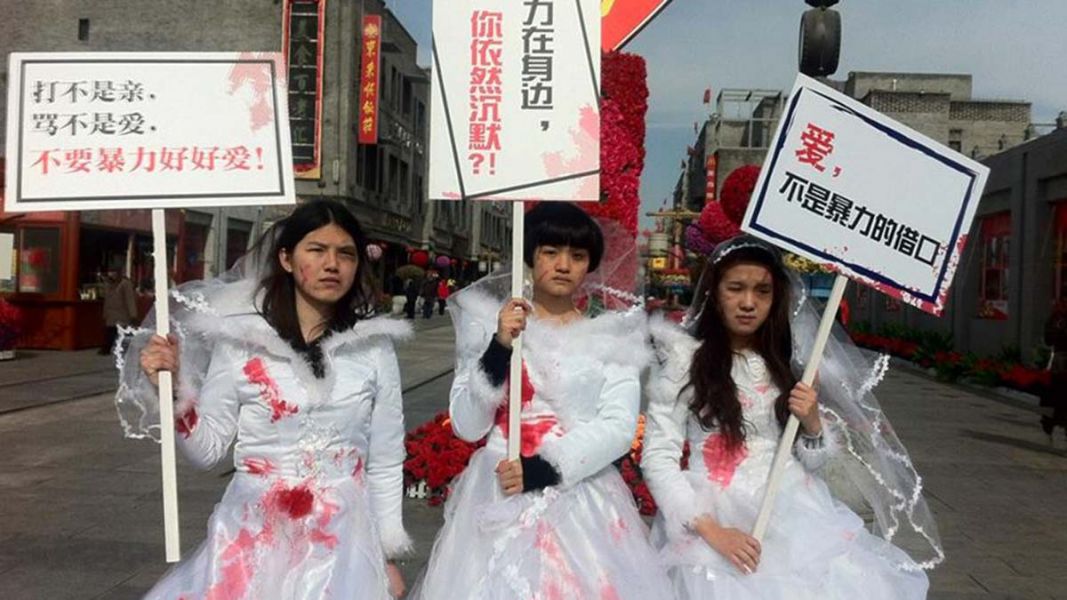
Does China Have a Feminist Movement from the Left?
The detention of the ‘Feminist Five’ in March 2015 and the subsequent international campaign to free them marked a watershed moment for contemporary feminist movements in China (Wang 2015; Li 2017; see also Ristivojević’s essay in this issue). While Chinese women joined global feminist movements as early as the turn of the twentieth century, when the ‘first wave’ of feminism swept the world, most of their endeavours have remained marginal, if not totally ignored, in the public memory (Liu et al. 2013; Wang 1999; Wang and Zhang 2010; Wang 2016). To many, it was the ‘Feminist Five’ and the Young Feminist Activism (青年女权行动派, YFA) they represent that introduced the world to a new generation of Chinese women—outspoken, innovative, and fearlessly standing up to one of the most powerful authoritarian regimes in history.
While most media outside China reported this high-profile case positively and applauded the accompanying tidal wave of feminist awakening in China, some observers have pointed out that, as it is most visible on the Internet, these women’s voices and actions are biased towards urban middle-class interests and out of touch with the suffering of women in the migrant workforce or other lower social strata (Bai 2015; Dong 2016).
Is the YFA really a largely elite urban project? Does China have a feminist movement from the left? How do we think about the intersectionality between class and gender in the political-economic context of today’s China? To answer these questions, it is important to first and foremost ask those feminists who are fighting on the ground to define, narrate, and reflect on their activism. But as an sympathetic observer, I would like to discuss these questions here in order to highlight the connections between Chinese feminism and the ‘feminism for the 99 percent’, a new global movement in the making.
Inspired by mass movements for class justice, such as Occupy, the recently emerging ‘feminism for the 99 percent’ serves as a powerful critique of ‘neoliberal feminism’ or ‘corporate feminism’, pointing out that some legacies of the ‘second-wave’ feminism that started half a century ago have been appropriated by business elites and politicians for their personal advancement (Jaffe 2017). ‘Feminism for the 99 percent’ calls for a renewed struggle that goes beyond identity politics to address deep-seated structural problems, including forms of class and racial oppression that intersect with gender inequalities (Arruzza et al. 2019; see also Kehoe’s essay in this issue). At this historical conjuncture, with the increasing visibility of women’s power from China, it would be inspiring to see how contemporary Chinese feminism can not only contribute to, but also possibly transform, this new global wave.
Drawing on my observation and personal engagement in Chinese feminist movements over the last decade, in this essay I will argue that while the feminist upsurge in China shares the common anti-authoritarian features of many urban, middle-class-oriented movements, it is by no means confined within the urban elite sphere. Moreover, the present gender-cum-class structure in China is more than ever conducive to feminist forces from the left, as worsening class inequalities have made struggles for gender justice in most social spheres simultaneously intersectional with questions of economic justice.
Deconstructing the Myth of Privilege
Before delving into the question of gender-cum-class structure, it is first necessary to deconstruct the myth that members of the YFA are privileged urban college graduates and thus blind to class injustice—a common assertion found among observers who are too quick to apply the established critique of corporate feminism—which is derived from the Global North—to the Chinese context. One immediate counterpoint is that, right after the arrest of the ‘Feminist Five’, labour activists based in Guangdong and Hong Kong weighed in, maintaining that they were standing in solidarity with these feminists because when labour activists had been previously threatened by the authorities, those feminists had stood with the workers (China Citizens Movement 2015; Gongpingshe 2015).
A careful reading of the biographies of key members of the YFA quickly reveals that a substantial number of them are from rural and working-class backgrounds. For example, three of the five detainees, Li Maizi, Wei Tingting, and Wu Rongrong, grew up in the countryside. While going to college in top-tier cities like Beijing, Guangzhou, and Xi’an has exposed them to cosmopolitan feminist ideas, they do not have the economic and social capital a typical middle-class, white-collar urbanite would have. In fact, according to Lü Pin, a prominent figure in the YFA, it was exactly due to the lack of resources and access to the established system that the young feminists had to rely on ‘drama and visuality’—such as the ingenious ‘bloody bride’ protest in a main street in Beijing in 2012—to draw public attention to the absence of legislation against domestic violence (Lü 2016).
Beyond individual class background, many of the social services and advocacy activities undertaken by YFA are for people at the margins of society, including migrants, sex workers, domestic workers, and peasant women. For example, the same group of young feminists who did the ‘bloody bride’ protest also campaigned for equal economic rights for rural women. On 12 December 2013, with the help of the YFA, He Zhuqing and other seven peasant women who had lost their land after marriage or divorce gathered in front of the office of the Zhejiang Provincial Government in Hangzhou. They laid down on the street and formed a ‘human pyramid’, with slogans covering their bodies: ‘Married-out women are like thrown-out water’ and ‘The tyranny of valuing men highly and women lightly’ (Gender Watch 2014).
Furthermore, many of the YFA’s battles have actually dealt with the livelihoods of women coming from lower social strata. Take a widely reported case for example. In January 2015, Ma Hu, a 25-year-old lesbian feminist, sued China Post, the state-owned enterprise that monopolises postal services. Coming from a village in northeast China and having a college degree in fine arts, Ma struggled to stay in Beijing and was attempting to get a job in express delivery to make ends meet. China Post denied her application because, as she was repeatedly told by the managers, ‘only men would suit the job’. After a court in Beijing ruled in her favour, her case became the first successful employment gender-discrimination lawsuit against a state-owned enterprise (Xiao 2018). This was preceded by a similar case in 2014, in which Huang Rong, another activist connected to the YFA, sued the New Oriental Culinary School in Hangzhou, Zhejiang province, after her job application there had been denied. It is believed that this was the first time a job-seeker won a gender discrimination case in China (Stauffer 2018).
It is notable that both Ma Hu and Huang Rong grew up in rural China. To fight for feminist causes, they chose to start with gender justice in employment, which is hardly an ‘elitist’ concept. Their relatively low socioeconomic status reflects the fact that many aspects of gender-related injustice in today’s China are closely tied to women’s overall class disadvantage and their fewer chances for upward mobility—a structural problem in which gender and class vulnerabilities are mutually reinforced.
Gender and Class in Today’s China
This leads into a structural analysis of gender/class intersectionality in contemporary China. Over the last four decades, the country’s reintegration into global capitalism has brought forth unprecedented class discrepancies. The government’s turn away from state feminism—which used to be part of the socialist project before the reform—has given rise to a new gender order that has restored the essentialist perception of women as sexual objects and primary caregivers. These two sources of inequality, namely class and gender, are strongly correlated.
Consistent with global trends, the gender gap in education in China has been almost eliminated, with women now outnumbering men at every stage of schooling. According to data from the All-China Women’s Federation (ACWF), as of 2010, 30 percent of Chinese women under 30 years old had a college degree, compared to only 26 percent of men (ACWF 2010). However, attainment in education has not translated into economic parity. While Chinese women’s average income has been steadily increasing since the beginning of the market reforms, the gender pay gap has also widened. Between 1990 to 2010, the average income of Chinese urban women relative to men had decreased from 78 to 67 percent, while for their rural counterparts this ratio had decreased from 79 to 60 percent (ACWF 2000; 2010). In general, the majority of Chinese women in their prime working age (18–64) belong to low or lower-middle income groups. In all types of enterprises and government offices, women only account for 2 percent of the leadership positions.
In addition to income, wealth accumulation is another avenue where Chinese women are left behind. Whereas housing is the most important and valuable private property a Chinese family can possess, due to patriarchal norms, in most Chinese families it is the husband who holds the property title (Fincher 2014). For all housing properties nationwide, only 38 percent have women as the owner or joint-owner (ACWF 2010). Only 13 percent of married women in China have housing property under their own name, and 28 percent share the ownership with their husbands, while half of the married men have property under their own name. As of 2010, 21 percent of rural women in China did not have the rights to any land, 9 percent higher than that of men. Compared to men, women are more likely to lose their rights to land as a result of marriage or divorce (ACWF 2010).
Furthermore, if we look at the breakdown of gender composition by occupation, it is clear that men dominate jobs at the middle and upper strata in terms of social and/or economic prestige—such as doctors, engineers, logistics, and other high-skilled, high value-added jobs. For example, the IT industry has one of the greatest gender imbalances: for every 100 programmers, there are only 6 women (CNNIC 2018).
While the high-growth, high-income industries are male dominated, a mirroring gender division of labour defines the service sector. Having surpassed industrial manufacturing, services have recently become the largest labour market in China, which includes low-end service jobs such as domestic servants, hotel workers, and retail personnel (Wu 2015). As a highly feminised sector, the service labour market is also highly informalised, with few regulations and labour protections. For example, 90 percent of the 21.62 million paid domestic workers in China are women who are either laid-off workers or rural migrants (Oxfam Hong Kong 2016). Despite recent efforts to standardise the quality of services—meant as a measure to satisfy the consumer—there are not yet any regulations or laws to protect service workers’ rights (Li 2015).
The exacerbating gender discrepancies and the strict gender division of labour between ‘high-end technology’ and ‘low-end service’ will also shape the future possibilities of labour organising: to organise workers in those informal, low-end sectors—an ever more urgent task as manufacturing jobs are leaving China—would mean to organise a highly-feminised labour force. In this context, addressing women’s rights would require engaging with issues of labour protection, social welfare, land rights, and the redistributive politics in general.
Unintended Conjunctures
In addition to changing gender and class structures, the current dire political situation in China is also playing a role in shaping the relationship between the feminist and labour movements. Since the government crackdown on the YFA in 2015, more than a hundred human rights lawyers, labour activists, and NGO organisers have been harassed and detained, with dozens of them being charged, tried, and sentenced (Gan 2018). As the state tightens its grip on political activism and resources for civic mobilisation dry up, an unintended conjuncture seems to be emerging where social forces that used to fight for different causes are joining together. On the ground, we have seen the convergence of struggles against gender injustice and labour oppression.
For instance, Jianjiao Buluo (尖椒部落), an Internet platform established recently, has been publishing content that addresses issues at the intersection of gender and labour, including stories written by women workers themselves. A recent example is an essay published in 2018 under the pen name ‘a female Foxconn worker’, requesting the enterprise to establish regulations against workplace sexual harassment.
January 2018 was the same month that the global #MeToo campaign started gaining momentum on the Chinese Internet (see Lam’s conversation with Zhang Leilei in this issue). To be sure, many Chinese people had started campaigning against sexual harassment and assault in workplace and academic setting years before the #MeToo movement. As early as 2014, 256 Chinese scholars and students signed an open letter urging the Ministry of Education to create anti-sexual harassment policies for university campuses (Liang 2018). In April 2018, Yue Xin, a senior at Peking University, and other student activists held demonstrations on campus, demanding that the university administration release the case file of Shen Yang, a professor facing allegations of raping a student 20 years ago and possibly causing her suicide. Long before emerging as a leading voice in the Chinese #MeToo movement, for years Yue Xin had been an active member in the Peking University Marxist Society—a leftist organisation fighting for social justice including for the rights of dispatched workers on campus. Later in July, Yue Xin and students from various universities travelled to Shenzhen to support workers who were on strike, protesting against low pay, long hours, and the undemocratic election of the trade union leaders in Jasic Technology (Shephard 2018; Zhang 2019).
Another female activist who stood out in the Jasic incident was Sheng Mengyu. After graduating from Sun Yat-Sen University with a STEM master’s degree in 2015, she started a job on the assembly line, hoping to get in touch with workers and to help improve their situation (Zheng 2018). Her activism has specifically focussed on protecting the rights of female workers, especially their maternity health and benefits. This is not a coincidence. The history of labour movements, including that of the early Chinese Communist Party, has taught us that female activists and organisers have more access to women and more insight into women’s particular disadvantages and needs.
While we have to wait and see whether and how the labour and feminist movements can break the siege and move forward, given the gender-cum-class condition and the already connected networks between labour and feminist activists, stronger solidarity between the two—as well as other social forces—is highly plausible. It is in this light that I believe contemporary Chinese feminism can play a vital role in shaping the ‘feminism for the 99 percent’ on a global scale, as many of the gender and class patterns in China, as well as the grim political situation, can also be found in other parts of the world.





